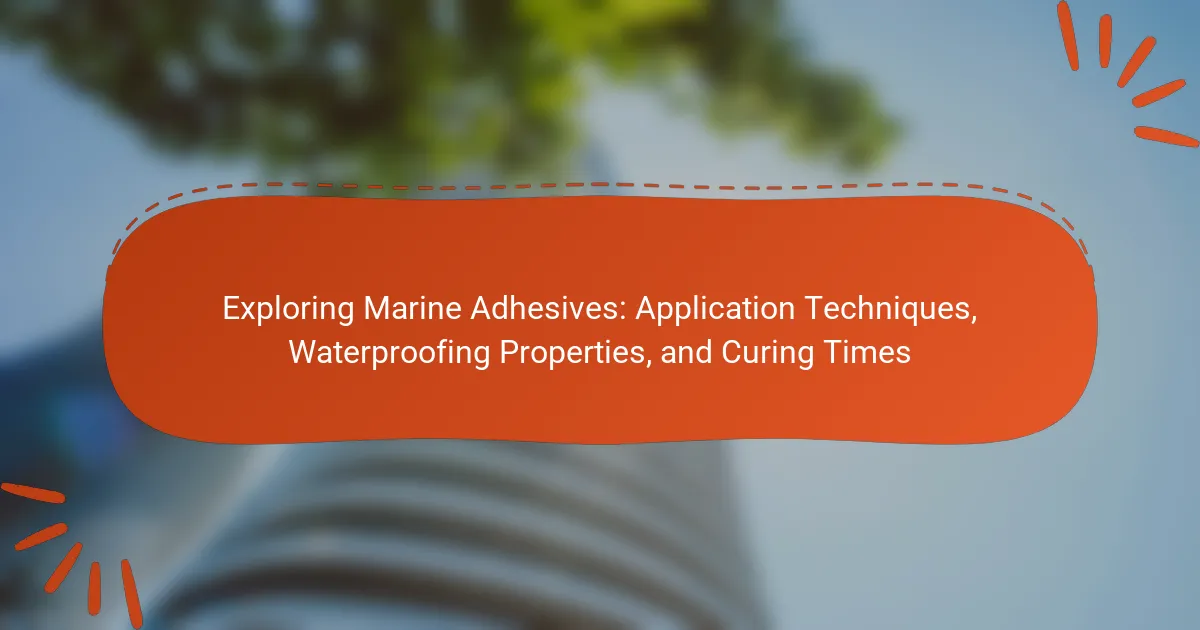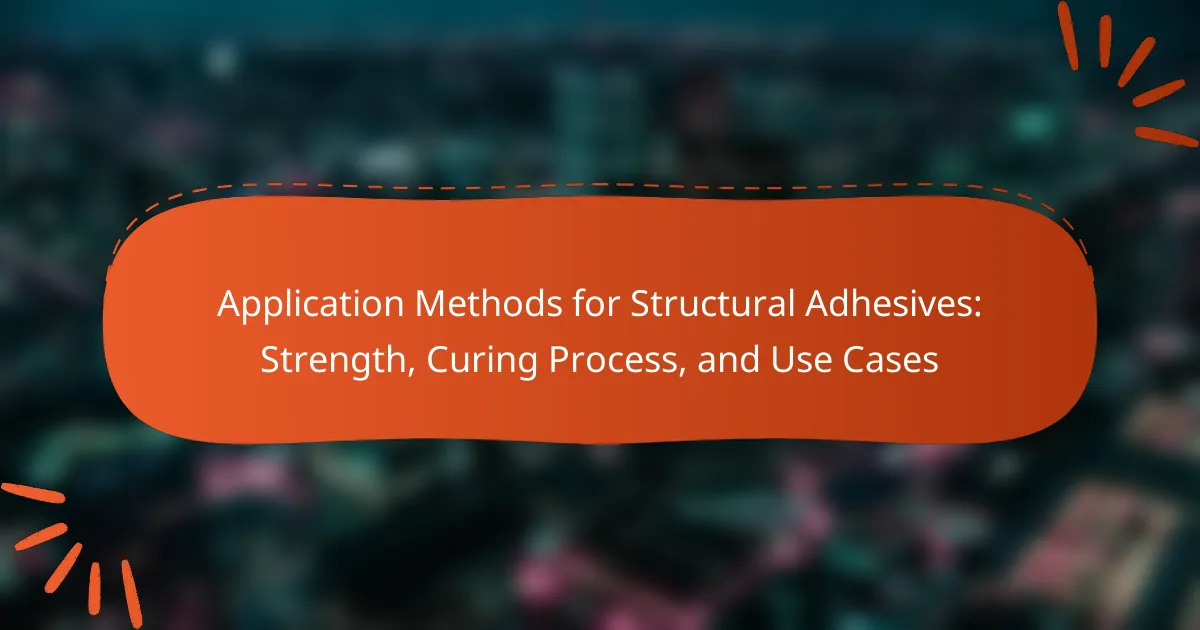Marine adhesives are specialized bonding agents formulated for use in aquatic environments, designed to endure harsh conditions such as water exposure and extreme temperatures. This article explores the application techniques, waterproofing properties, and curing times associated with marine adhesives. Key materials include epoxy, polyurethane, and silicone, which provide strong adhesion to various substrates like wood, fiberglass, and metal. The article details effective application methods, emphasizing the importance of surface preparation and proper curing to achieve optimal bond strength and durability. Additionally, it highlights the exceptional waterproofing capabilities of these adhesives, essential for reliable performance in boat construction and repair.
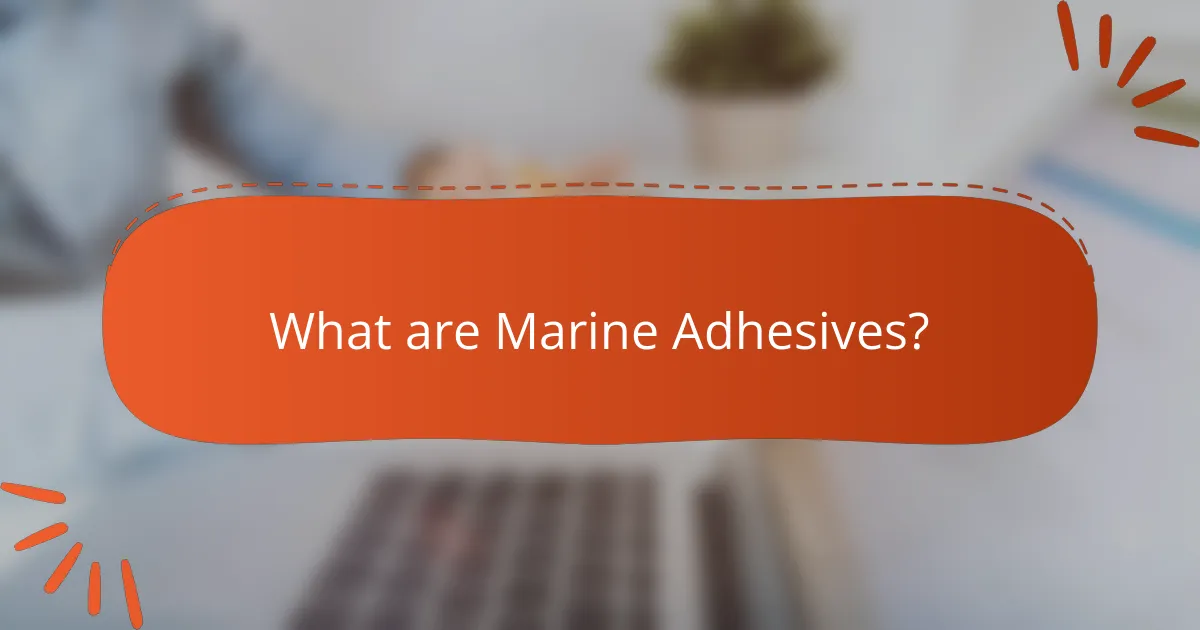
What are Marine Adhesives?
Marine adhesives are specialized bonding agents designed for use in marine environments. They are formulated to withstand harsh conditions such as water exposure and extreme temperatures. These adhesives often feature waterproof properties, ensuring durability in wet conditions. Common materials used in marine adhesives include epoxy, polyurethane, and silicone. They provide strong adhesion to various substrates, including wood, fiberglass, and metal. Marine adhesives are essential for applications like boat construction, repair, and maintenance. Their effectiveness is validated by their widespread use in the marine industry, where reliability is crucial.
How do Marine Adhesives differ from other adhesives?
Marine adhesives differ from other adhesives primarily in their formulation and performance characteristics. They are specifically designed to withstand harsh marine environments. This includes exposure to water, temperature fluctuations, and UV radiation. Marine adhesives often contain additives that enhance their waterproofing capabilities. They also possess superior bonding strength to materials commonly used in marine applications, such as fiberglass and metals. Additionally, marine adhesives typically have longer curing times to ensure optimal bonding under challenging conditions. These properties make them essential for boat construction and repair, where durability and reliability are critical.
What are the unique properties of Marine Adhesives?
Marine adhesives possess unique properties that make them suitable for use in aquatic environments. They are specifically designed to withstand exposure to water, humidity, and temperature fluctuations. These adhesives often exhibit exceptional bonding strength to various substrates, such as wood, fiberglass, and metals.
Additionally, marine adhesives are typically resistant to chemicals and UV light, ensuring durability over time. Many formulations cure quickly, allowing for efficient application and repair. Some marine adhesives are also flexible, accommodating the movements of boats and structures.
These properties are critical for maintaining the integrity of marine vessels and infrastructure. For instance, the ability to resist water [censured] is essential for preventing structural damage. Overall, these unique characteristics ensure that marine adhesives perform reliably in challenging conditions.
Why are these properties important for marine applications?
The properties of marine adhesives are crucial for ensuring durability and performance in harsh marine environments. Waterproofing properties prevent water ingress, which can lead to material degradation. Strong adhesion is essential to withstand dynamic loads and vibrations experienced in marine settings. Resistance to corrosion protects bonded materials from saltwater damage. Curing times impact the speed of repairs and construction, allowing for timely project completions. These factors contribute to the overall safety and longevity of marine structures and vessels.
What types of Marine Adhesives are available?
There are several types of marine adhesives available. Common categories include epoxy adhesives, polyurethane adhesives, and cyanoacrylate adhesives. Epoxy adhesives are known for their strong bond and resistance to water and chemicals. Polyurethane adhesives offer flexibility and durability in marine environments. Cyanoacrylate adhesives provide quick bonding for small repairs. Each type serves specific applications in marine settings. Their effectiveness is supported by their respective chemical properties and bonding capabilities.
What are the common formulations of Marine Adhesives?
Common formulations of marine adhesives include epoxy, polyurethane, and cyanoacrylate. Epoxy adhesives are known for their strong bonding capabilities and resistance to water. They are often used in boat construction and repairs. Polyurethane adhesives offer flexibility and durability, making them suitable for various marine applications. Cyanoacrylate adhesives provide quick bonding for small repairs but may not withstand prolonged exposure to water. These formulations are designed to meet the specific needs of marine environments, ensuring effective adhesion and longevity.
How do different types of Marine Adhesives cater to specific needs?
Different types of marine adhesives cater to specific needs by offering varied properties for distinct applications. For example, epoxy adhesives provide strong bonds and excellent resistance to water and chemicals. They are ideal for structural repairs and bonding dissimilar materials. Polyurethane adhesives are flexible and can absorb shock, making them suitable for applications where movement occurs. Silicone adhesives offer high flexibility and are often used for sealing joints and gaps in boats. Each adhesive type is formulated to meet requirements like temperature resistance, curing time, and substrate compatibility. This specificity ensures optimal performance for various marine environments and conditions.
What are the key applications of Marine Adhesives?
Marine adhesives are primarily used in boat construction and repair. They bond various materials such as wood, fiberglass, and metal. These adhesives are essential for ensuring watertight seals. They are also used for assembling hulls and decks. Additionally, marine adhesives are utilized in the installation of fittings and hardware. They provide structural integrity in high-stress areas. Their waterproof properties make them suitable for underwater applications. The versatility of marine adhesives supports diverse marine projects.
How are Marine Adhesives used in boat building?
Marine adhesives are used in boat building to bond various materials securely. They provide strong adhesion for wood, fiberglass, and metal components. These adhesives are specifically formulated to withstand harsh marine environments. They resist water, temperature fluctuations, and UV exposure. Marine adhesives also enhance structural integrity and longevity of the vessel. For example, epoxy-based adhesives are commonly used due to their excellent strength and waterproof properties. Additionally, polyurethane adhesives offer flexibility and durability, making them suitable for different applications in boat construction.
What role do Marine Adhesives play in repairs and maintenance?
Marine adhesives are crucial for repairs and maintenance in marine environments. They provide strong bonding for various materials, including wood, fiberglass, and metals. These adhesives are designed to withstand harsh conditions such as saltwater and extreme temperatures. They help prevent leaks and structural failures in boats and marine equipment. Marine adhesives also enhance the longevity of repairs by resisting water and environmental degradation. Their application is essential for ensuring safety and performance in marine applications. Studies show that using the right marine adhesive can significantly extend the lifespan of repaired components.
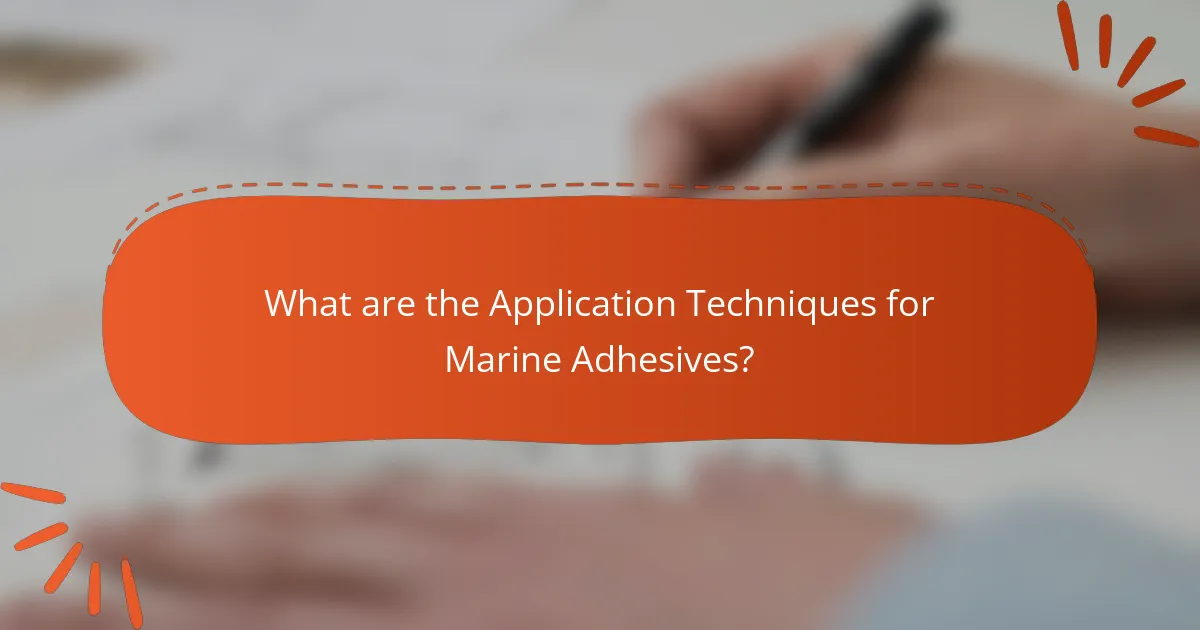
What are the Application Techniques for Marine Adhesives?
Application techniques for marine adhesives include surface preparation, mixing, application, and curing. Proper surface preparation involves cleaning and roughening surfaces to enhance adhesion. Mixing should follow the manufacturer’s instructions for optimal performance. Application can be done using brushes, rollers, or caulking guns, ensuring an even layer. Curing times vary based on the adhesive type and environmental conditions. For instance, polyurethane adhesives typically require 24 hours to cure fully. Following these techniques ensures strong bonds and durability in marine environments.
How should Marine Adhesives be applied for best results?
Marine adhesives should be applied on clean and dry surfaces for optimal adhesion. Surface preparation is critical; remove any dirt, grease, or old adhesive. Use a solvent or cleaner specifically designed for marine applications. Apply the adhesive evenly using a suitable applicator. Ensure the adhesive layer is consistent in thickness. Follow the manufacturer’s recommended curing time and conditions. Proper pressure should be applied to ensure a tight bond. Temperature and humidity can affect curing; adhere to specified ranges for best results. Testing adhesion strength after curing is advisable to confirm effectiveness.
What surface preparation is necessary before applying Marine Adhesives?
Surfaces must be clean, dry, and free of contaminants before applying marine adhesives. This preparation ensures optimal bonding strength. Remove any grease, oil, dirt, or old adhesive residues. Use a suitable cleaner or solvent for thorough cleaning. For porous surfaces, sanding may be necessary to create a better bond. Make sure to wipe down the surface after sanding to eliminate dust. Proper surface preparation significantly enhances adhesive performance and durability.
How does the application method affect the bond strength?
The application method significantly influences bond strength in marine adhesives. Different techniques, such as brushing, rolling, or spraying, can lead to variations in the thickness of the adhesive layer. Thicker layers generally enhance bond strength by increasing surface contact. Conversely, uneven application can create weak spots, reducing overall adhesion. Studies have shown that proper surface preparation prior to application also maximizes bond strength. For instance, cleaning and roughening surfaces can improve mechanical interlocking. Moreover, the curing process is affected by the application method, as some techniques may trap air or moisture, impacting the adhesive’s final properties.
What tools and equipment are recommended for applying Marine Adhesives?
Recommended tools for applying marine adhesives include caulking guns, brushes, and spatulas. A caulking gun aids in precise application of adhesive. Brushes help spread adhesive evenly on surfaces. Spatulas assist in smoothing out the adhesive for better adhesion. Additionally, using a roller can cover larger areas efficiently. Safety gear such as gloves and goggles is essential to protect during application. These tools ensure effective and safe application of marine adhesives.
What are the essential tools for effective adhesive application?
Essential tools for effective adhesive application include a caulking gun, brush, and roller. A caulking gun allows for precise application of adhesive. Brushes are useful for spreading adhesive in tight or intricate areas. Rollers can cover larger surfaces efficiently. Additionally, a putty knife helps in smoothing out adhesive and removing excess. Masking tape can protect areas from adhesive overflow. Safety gloves ensure user protection during application. Each tool enhances the efficiency and accuracy of adhesive application in marine settings.
How can proper equipment enhance the application process?
Proper equipment enhances the application process by ensuring precision and efficiency. High-quality tools allow for accurate measurements and consistent application of marine adhesives. For example, using a caulking gun provides better control over adhesive flow. This minimizes waste and ensures a strong bond. Additionally, specialized brushes or rollers can help distribute the adhesive evenly. Even application reduces the risk of weak spots that could compromise waterproofing. Ultimately, the right equipment leads to a more reliable and durable result in marine adhesive applications.
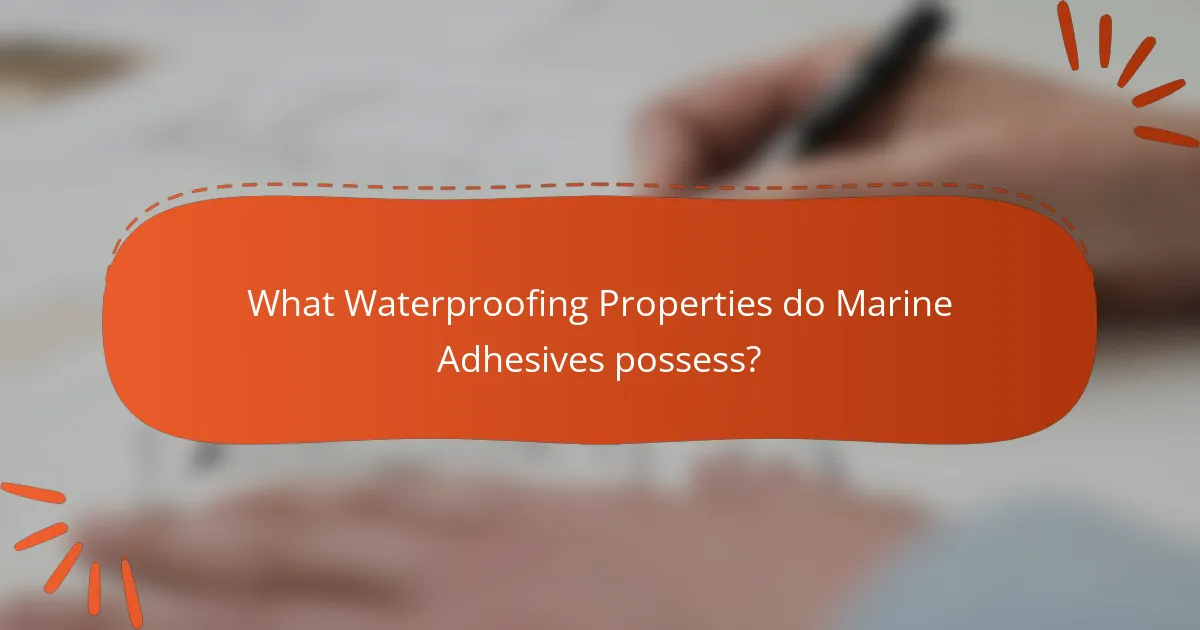
What Waterproofing Properties do Marine Adhesives possess?
Marine adhesives possess exceptional waterproofing properties. They are designed to create strong bonds that resist water intrusion. These adhesives typically have high resistance to moisture, preventing degradation over time. Many marine adhesives are formulated with specialized polymers that enhance their waterproof characteristics. They can withstand prolonged exposure to saltwater and freshwater environments. This durability is crucial for applications in boat building and repair. Additionally, some marine adhesives are also resistant to UV radiation, further extending their lifespan. Overall, the waterproofing properties of marine adhesives ensure reliable performance in aquatic settings.
How do Marine Adhesives ensure waterproofing?
Marine adhesives ensure waterproofing through their specialized formulations that resist water [censured]. These adhesives typically contain polymers that create a strong bond when cured. The curing process enhances their resistance to moisture. Many marine adhesives are designed to expand slightly upon curing, filling gaps and preventing leaks. Additionally, they often include additives that improve adhesion to various substrates, such as wood and fiberglass. This strong bond is crucial for maintaining waterproof integrity. The effectiveness of marine adhesives in waterproofing is supported by their use in boat construction and repair, where exposure to water is constant.
What testing methods are used to evaluate waterproofing properties?
Common testing methods to evaluate waterproofing properties include the water [censured] test, the hydrostatic pressure test, and the spray test. The water [censured] test measures the amount of water that penetrates through a material under controlled conditions. The hydrostatic pressure test evaluates the material’s ability to withstand water pressure over time. The spray test assesses how well a material resists water spray under specified conditions. These methods provide reliable data on the waterproofing effectiveness of various materials.
Why is waterproofing critical in marine environments?
Waterproofing is critical in marine environments to prevent water damage and corrosion. Marine structures are constantly exposed to saltwater, which can degrade materials over time. Waterproofing helps to create a barrier that protects surfaces from moisture intrusion. This barrier is essential for the longevity of boats, docks, and other marine installations. Studies show that untreated materials can suffer significant deterioration within a few years in marine conditions. Proper waterproofing can extend the lifespan of these structures by years. Additionally, waterproofing enhances safety by reducing the risk of structural failure due to water-related issues.
What factors influence the waterproofing effectiveness of Marine Adhesives?
The waterproofing effectiveness of marine adhesives is influenced by several factors. These include the adhesive formulation, which determines its chemical properties. The surface preparation of the materials being bonded is critical for achieving a strong bond. Environmental conditions during application, such as temperature and humidity, also play a significant role. The curing time affects the adhesive’s final strength and waterproofing capabilities. Additionally, the type of substrate, whether wood, fiberglass, or metal, can impact adhesion and waterproofing performance. Compatibility between the adhesive and substrate ensures optimal bonding. Lastly, the presence of contaminants on surfaces can hinder adhesion, reducing waterproofing effectiveness.
How do temperature and humidity affect adhesive performance?
Temperature and humidity significantly affect adhesive performance. High temperatures can accelerate curing times but may also lead to premature evaporation of solvents. Conversely, low temperatures can slow down curing, resulting in weaker bonds.
Humidity impacts the adhesion process as well. High humidity can introduce moisture into the adhesive, potentially compromising bond strength. Conversely, low humidity can lead to inadequate curing if the adhesive requires moisture to activate.
Research indicates that adhesives may have optimal temperature and humidity ranges for best performance. For example, a study by the Adhesive and Sealant Council found that many marine adhesives perform best at temperatures between 60°F and 80°F with relative humidity levels below 70%.
What role does substrate material play in waterproofing?
Substrate material is critical in waterproofing as it directly influences adhesion and the effectiveness of waterproofing systems. Different substrates, such as concrete, wood, or metal, have varying porosities and surface textures. These factors affect the bonding strength of waterproofing agents. For instance, porous substrates may absorb moisture, compromising the waterproofing layer. Conversely, non-porous surfaces may require specific primers for optimal adhesion. Research indicates that proper substrate preparation significantly enhances waterproofing performance. A study by the American Concrete Institute shows that surface cleanliness and texture can improve adhesive bonding by up to 50%. Therefore, selecting the right substrate and preparing it adequately is essential for effective waterproofing.

What are the Curing Times for Marine Adhesives?
Curing times for marine adhesives typically range from 24 hours to several days. The specific time depends on the adhesive type and environmental conditions. For example, epoxy adhesives generally cure within 24 to 48 hours. Polyurethane adhesives may require up to 72 hours for full cure. Temperature and humidity significantly influence curing times. Higher temperatures can accelerate the curing process. Conversely, lower temperatures may extend curing durations. Proper curing ensures optimal bond strength and waterproofing properties.
How do curing times vary among different types of Marine Adhesives?
Curing times for marine adhesives vary significantly based on the type of adhesive used. Epoxy adhesives typically cure within 24 hours, depending on the formulation and ambient conditions. Polyurethane adhesives generally have a curing time ranging from 1 to 7 days. Silicone adhesives can cure in 24 hours but may take longer in humid conditions. Cyanoacrylate adhesives cure rapidly, often within minutes, but their bond strength may not be suitable for all marine applications. The curing time is influenced by factors such as temperature, humidity, and adhesive formulation. Therefore, selecting the appropriate adhesive type is crucial for specific marine applications.
What factors can impact curing time?
Curing time is influenced by several factors. Temperature is a primary factor; higher temperatures generally accelerate curing. Humidity levels also play a role; higher humidity can slow down the curing process. The type of adhesive used significantly affects curing time; different formulations have varying chemical properties. Surface preparation impacts curing; clean and properly prepared surfaces enhance adhesion and speed up curing. Additionally, thickness of the adhesive layer can affect curing; thicker applications may take longer to cure. Lastly, the presence of catalysts or accelerators can reduce curing time. These factors collectively determine how quickly marine adhesives achieve their optimal bond strength.
How can users speed up the curing process if needed?
Users can speed up the curing process of marine adhesives by increasing the temperature and humidity levels. Warmer temperatures generally accelerate chemical reactions, leading to faster curing times. For instance, a temperature increase of 10 degrees Celsius can double the curing speed for some adhesives. Additionally, maintaining higher humidity can enhance moisture curing adhesives, which rely on humidity for activation. Users should also ensure proper surface preparation, as clean and roughened surfaces promote better adhesion and faster curing. Using fans or heat lamps can further enhance airflow and warmth, contributing to quicker curing.
What are the implications of curing time on project timelines?
Curing time significantly impacts project timelines. Delays in curing can extend overall project duration. For instance, marine adhesives often require specific curing periods to achieve optimal strength. If these times are not accounted for, project schedules can be disrupted. Additionally, environmental factors can influence curing, leading to unexpected delays. Accurate planning must include curing time to avoid complications. This ensures that subsequent project phases can proceed as planned. Failure to consider curing time can result in increased labor costs and resource allocation issues.
How should project planning account for curing times?
Project planning should integrate curing times as a critical factor in scheduling. Curing times vary based on the type of adhesive used. For marine adhesives, these times can significantly affect the project’s timeline. Understanding the specific curing duration allows for accurate scheduling of subsequent tasks. Delays in curing can lead to project overruns and increased costs. Additionally, planning should consider environmental conditions that may influence curing rates. Factors such as temperature and humidity can alter the expected curing time. Incorporating these elements ensures a smoother project flow and reduces the risk of errors. Properly accounting for curing times enhances overall project efficiency and effectiveness.
What best practices can ensure optimal curing conditions?
Maintain stable temperature and humidity levels to ensure optimal curing conditions. Ideal temperatures range from 60°F to 90°F. Humidity levels should be kept below 70% for best results. Proper ventilation is essential to facilitate the curing process. Avoid direct sunlight during curing, as it can cause uneven curing. Use recommended adhesive thickness to promote uniform curing. Follow manufacturer guidelines for curing times, as they vary by product. Conduct periodic checks to ensure conditions remain consistent throughout the curing period. These practices enhance the performance and durability of marine adhesives.
What are some common troubleshooting tips for Marine Adhesives?
Common troubleshooting tips for marine adhesives include ensuring proper surface preparation. Clean surfaces remove contaminants that can impede adhesion. Another tip is to check the temperature and humidity levels. Optimal conditions enhance curing and bond strength. Additionally, verify the adhesive’s compatibility with the materials being bonded. Incompatible materials can lead to weak joints. If the adhesive is not curing properly, consider adjusting the application thickness. Excessive thickness can hinder proper curing. Lastly, consult the manufacturer’s guidelines for specific instructions. Following these tips can help achieve a strong and durable bond.
How can users identify and resolve common application issues?
Users can identify and resolve common application issues with marine adhesives by following systematic troubleshooting steps. First, they should check the surface preparation. Properly cleaned and dry surfaces enhance adhesion. Second, users must verify the adhesive type and compatibility with materials. Different adhesives have specific applications. Third, they should assess the curing conditions. Temperature and humidity can affect curing times and effectiveness. Fourth, users should observe the application technique. Applying the adhesive evenly prevents weak spots. If issues persist, consulting manufacturer guidelines provides additional insights. Lastly, users can seek advice from experienced professionals or forums for complex problems.
What maintenance tips can help prolong the effectiveness of Marine Adhesives?
To prolong the effectiveness of marine adhesives, store them in a cool, dry place. Exposure to heat and humidity can degrade adhesive properties. Ensure that the adhesive containers are tightly sealed after use. This prevents moisture from entering and compromising the adhesive. Clean surfaces thoroughly before application to enhance bonding strength. Any contaminants can weaken the adhesion. Inspect bonded areas regularly for signs of wear or damage. Timely repairs can prevent further deterioration. Follow the manufacturer’s guidelines for curing times and application conditions. Adhering to these specifications can significantly enhance performance.
Marine adhesives are specialized bonding agents formulated to endure harsh marine environments, characterized by their waterproof properties and strong adhesion to various substrates such as wood, fiberglass, and metal. The article explores the unique properties and applications of marine adhesives, including their differences from other adhesives, types available, and specific formulations suited for marine use. It also details application techniques, curing times, and factors influencing performance, emphasizing the importance of proper surface preparation and environmental conditions for optimal results. Additionally, the article addresses troubleshooting tips and maintenance practices to ensure the longevity and effectiveness of marine adhesives in boat construction and repair.
